Genesis of the Dongtangzi Zn-Pb Deposit of the Fengxian–Taibai Ore Cluster in West Qinling, China: Constraints from Rb-Sr and Sm-Nd Geochronology, and In Situ S-Pb Isotopes
Abstract
:1. Introduction
2. Regional Geology
3. Ore Deposit Geology
3.1. Structures
3.2. Rocks
3.3. Orebodies
3.4. Mineralogy Assemblage and Paragenetic Sequence
3.4.1. Sedimentary Period
3.4.2. Hydrothermal Mineralization Period
Stage I: A Polymetallic Sulfide–Ankerite–Quartz Stage
Stage II: A Quartz–Pyrite-rich Sulfide–Ankerite Stage
Stage III: A Quartz–Carbonate–Sulfide Stage
4. Samples and Analytical Methods
4.1. CL and SEM
4.2. In Situ S Isotope Analysis
4.3. In Situ Pb Isotope Analysis
4.4. Rb–Sr Isotope Analyses
4.5. Sm–Nd Isotope Analyses
5. Results
5.1. In Situ S Isotopic Compositions
5.2. In Situ Pb Isotopic Compositions
5.3. Rb–Sr Isochron Age
5.4. Sm-Nd Isochron Age
6. Discussion
6.1. Sources of Sulfur and Metals
6.1.1. Source of Sulfur
6.1.2. Source of Lead
6.2. Timing of the Ore Formation
6.3. Ore Genesis
7. Conclusions
Author Contributions
Funding
Data Availability Statement
Acknowledgments
Conflicts of Interest
References
- Wang, R.T.; Wang, T.; Gao, Z.J.; Chen, E.H.; Liu, L.X. The main metal deposits metallogenic series and exploration direction in Feng-Tai Ore Cluster Region, Shaanxi Province. West. Geol. 2007, 40, 77–84, (In Chinese with English Abstract). [Google Scholar]
- Li, J.H. Analysis on ore-controlling factors and prospecting potential of the Baguamiao-type gold deposits in Fengtai area, Shaanxi. Miner. Resour. Geol. 2008, 22, 62–64, (In Chinese with English Abstract). [Google Scholar]
- Wu, X.D.; Song, S.K.; Gao, W.H.; Yang, S.W.; Zhang, X.G. Geological Characteristics and Prospecting Direction of Lead-Zinc Mine in Shaanxi Qiandongshan-Dongtangzi. Gansu Metall. 2016, 38, 87–94, (In Chinese with English Abstract). [Google Scholar]
- Zhang, F.X. Characteristics and geological significance of the strawberry-like sulfide mineral in the lead-zinc deposit of Qiandongshan and Yinmusi in Shaanxi province. Geol. Prospect. 1986, 22, 40–42. [Google Scholar]
- Wang, J.L.; He, B.C.; Li, J.Z.; He, D.R. Qinling-Type Lead-Zinc Ore Deposits in China; Geological Publishing House: Beijing, China, 1996; pp. 116–145, (In Chinese with English Abstract). [Google Scholar]
- Wang, Y.T.; Hu, Q.Q.; Wang, R.T.; Gao, W.H.; Chen, S.C.; Wei, R.; Wang, C.A.; Wen, B.; Wen, S.W.; Tang, M.J. A new metallogenic model and its significance in search for Zn-Pb deposits in Fengtai (Fengxian-Taibai) polymetallic ore concentration area, Shannxi Province. Miner. Deposits 2020, 39, 587–606, (In Chinese with English Abstract). [Google Scholar]
- Fang, W.X. Research on mineral geochemistry of Qiandongshan Lead-Zinc deposit, a large-sized deposit in Fengxian County, Shaanxi. Acta Mineral. Sinica 1999, 19, 198–205, (In Chinese with English Abstract). [Google Scholar]
- Fang, W.X. Characteristics of sedimentary facies of hydrothermal for the giant Qiantongshan Lead-zinc ore deposit, Feng County, Shanxi Province. Acta Sedimentol. Sinica 1999, 17, 44–50, (In Chinese with English Abstract). [Google Scholar]
- Huang, Z.Y.; Lu, R.A. Zoning characteristics and index of primary geochemical anomalies in Qiandongshan Pb-Zn deposit Shaanxi Province, China. Geol. Prospec. 2003, 39, 39–44, (In Chinese with English Abstract). [Google Scholar]
- Ren, P.; Liang, T.; Liu, K.L.; Niu, L.; Lu, L.; Zhang, W.J. Geochemistry of Sulfur and Lead Isotopic Compositions of Sedex Lead-zinc Deposits in Fengtai Mineral Cluster Region of Qinling Mountains. Northwest. Geol. 2014, 47, 137–149, (In Chinese with English Abstract). [Google Scholar]
- Zhang, G.L.; Tian, T.; Wang, R.T.; Gao, W.H.; Chang, Z.D. S, Pb isotopic composition of the Dongtangzi Pb–Zn deposit in the Fengtai ore concentration area of Shaanxi Province for tracing sources of ore–forming materials. Geol. China 2020, 47, 472–484, (In Chinese with English Abstract). [Google Scholar]
- Li, H. Sulfides typomorphism and genesis of the Qiandongshan Pb-Zn deposit in Feng Country. Geol. Prospect. 1986, 22, 36–41. (In Chinese) [Google Scholar]
- Yang, X.K. Comments on the genesis of the Qiandongshan Pb-Zn deposit in Fengtai area, Qinling. Northwest Geol. 1991, 4, 52–55. (In Chinese) [Google Scholar]
- Li, J.Z.; He, D.R.; Wu, J.M. The Qinling-type Lead and Zinc ore deposit. Acta Geol. Sinica 1992, 66, 257–268. [Google Scholar]
- Qi, S.J.; Li, Y. TheTypes and Ore-Controlling Factors of Lead-Zinc Deposits in the Devonian Metallogenic Belt of Qinling Mountain; Geological Publishing House: Beijing, China, 1993; pp. 1–178, (In Chinese with English Abstract). [Google Scholar]
- Wang, Y.T.; Mao, J.W.; Hu, Q.Q.; Wei, R.; Chen, S.C. Characteristics and Metallogeny of Triassic polymetallic mineralization in Xicheng and Fengtai ore cluster zones, west Qinling, China and their implications for prospecting targets. J. Earth Sci. Environ. 2021, 43, 409–435, (In Chinese with English Abstract). [Google Scholar]
- Shi, Y.H.; Wang, Y.; Chen, B.L.; Tan, R.W.; Gao, Y.; Shen, J.H. Characteristics of silicon-calcium surface ore-controlling in Fengtai ore-concentration areas, West Qinling Mountains: Examples from Qiandongshan Pb-Zn deposit. Geol. China 2022, 49, 226–240, (In Chinese with English Abstract). [Google Scholar]
- Hu, Q.Q.; Wang, Y.T.; Mao, J.W.; Liu, X.L.; Chen, S.C.; Wei, R.; Zhang, J.; Wang, R.T.; Wang, C.A.; Dai, J.Z.; et al. Genesis of the Bafangshan-Erlihe Zn-Pb-Cu deposit in the Fengxian-Taibai ore cluster, west Qinling, China: Evidence from ore geology and ore-forming fluids. Ore Geol. Rev. 2020, 126, 103734. [Google Scholar] [CrossRef]
- Wang, X.; Tang, R.Y.; Li, S.; Li, Y.X.; Yang, M.J.; Wang, D.S.; Guo, J.; Liu, P.; Liu, R.D.; Li, W.Q. Qinling Orogeny and Metallogenesis. Metallurgical Industry Press: Beijing, China, 1996; pp. 187–230, (In Chinese with English Abstract). [Google Scholar]
- Zhang, F.X.; Wang, J.F. The submarine volcanic-exhalative-sedimentary origin of Lead-Zinc deposits in the Fengtai ore field, Shaanxi. Geol. Rev. 1988, 34, 157–168, (In Chinese with English Abstract). [Google Scholar]
- Hu, Q.Q. The Mineralization Features, Mechanism and Metallogenic Regularity of the Fengtai Pb-Zn Polymetallic Ore Cluster in West Qinling. Ph.D. Thesis, Chinese Academy of Geological Sciences, Beijing, China, 2015. [Google Scholar]
- Zhang, G.W.; Cheng, S.Y.; Guo, A.L.; Dong, Y.P.; Lai, S.C.; Yao, A.P. Mianlue paleo-suture on the southern margin of the Central Orogenic System in Qinling-Dabie— with a discussion of the assembly of the main part of the continent of China. Geol. Bull. China 2004, 23, 846–852, (In Chinese with English Abstract). [Google Scholar]
- Wang, Y.T.; Liu, X.L.; Hu, Q.Q.; Zhang, J.; Chen, S.C.; Wang, R.T.; Dai, J.Z.; Gao, W.H.; Wen, S.W.; Chen, M.S.; et al. Rb-Sr isotopic Dating of Vein-like Sphalerites from the Chaima Au Deposit in Fengxian-Taibai Ore-concentration Area, Shaanxi Province and Its Geological Significance. Northwest. Geol. 2018, 51, 121–132, (In Chinese with English Abstract). [Google Scholar]
- Wang, R.; Pang, Z.; Li, Q.; Zhang, G.; Zhang, J.; Cheng, H.; Wu, W.; Yang, H. Metallogenic Model and Prospecting Progress of the Qiandongshan–Dongtangzi Large Pb-Zn Deposit, Fengtai Orefield, West Qinling Orogeny. Minerals 2023, 13, 1163. [Google Scholar] [CrossRef]
- Chen, S.C.; Wang, Y.T.; Yu, J.J.; Hu, Q.Q.; Zhang, J.; Wang, R.T.; Gao, W.H.; Wang, C.A. Petrogenesis of Triassic granitoids in the Fengxian–Taibai ore cluster, Western Qinling Orogen, central China: Implications for tectonic evolution and polymetallic mineralization. Ore Geol. Rev. 2020, 123, 103577. [Google Scholar] [CrossRef]
- Zeng, L.G.; Zhang, J.; Hu, P. Spatio-temporal structure of the mineralization for Fengtai lead-zinc mineral cluster region, Shaanxi. Geol. Sci. Technol. Inf. 2009, 28, 84–90. [Google Scholar]
- Lu, R.S.; Wei, H.M. Characteristics and Genesis of the Silicalites in Hot-Water Sedianentary Lead-Zinc Deposits in the Qinling Mountains. Acta Petrol. Mineral. 1992, 11, 14–21, (In Chinese with English Abstract). [Google Scholar]
- Fang, W.X. Geochemical anomaly pattern and metallogenic model of the Bafangshan polymetallic deposit, Shaanxi. Geol. Explor. Non-Ferrous Metals 1997, 6, 167–171, (In Chinese with English Abstract). [Google Scholar]
- Fu, J.L.; Hu, Z.C.; Zhang, W. In Situ Sulfur Isotopes (δ34S and δ33S) Analyses in Sulfides and Elemental Sulfur Using High Sensitivity Cones Combined with the Addition of Nitrogen by Laser Ablation MC-ICP-MS. Anal. Chim. Acta 2016, 911, 14–26. [Google Scholar] [CrossRef]
- Zhu, Z.Y.; Cook, N.J.; Yang, T.; Ciobanu, C.L.; Zhao, K.D.; Jiang, S.Y. Mapping of sulfur isotopes and trace elements in sulfides by LA-(MC)-ICP-MS: Potential analytical problems, improvements and implications. Minerals 2016, 6, 14. [Google Scholar] [CrossRef]
- Zhu, Z.Y.; Jiang, S.Y.; Ciobanu, C.L.; Yang, T.; Cook, N.J. Sulfur isotope fractionation in pyrite during laser ablation: Implications for laser ablation multiple collector inductively coupled plasma mass spectrometry mapping. Chem. Geol. 2017, 450, 223–234. [Google Scholar] [CrossRef]
- Ding, T.; Valkiers, S.; Kipphardt, H.; De Bievre, P.; Taylor, P.; Gonfiantini, R.; Krouse, R. Calibrated sulfur isotope abundance ratios of three IAEA sulfur isotope reference materials and V-CDT with a reassessment of the atomic weight of sulfur. Geochim. Cosmochim. Acta 2001, 65, 2433–2437. [Google Scholar] [CrossRef]
- Chen, K.Y.; Yuan, H.L.; Bao, Z.A. Accurate and precise in situ determination of lead isotope ratios in NIST, USGS, MPI-DING and CGSG reference glasses using femtosecond laser ablation MC-ICP-MS. Geostand. Geoanal. Res. 2014, 38, 5–21. [Google Scholar]
- Yuan, H.L.; Yin, C.; Chen, K.Y.; Bao, Z.A.; Zong, C.; Dai, M.N.; Lai, S.C.; Wang, R.; Jiang, S.Y. High precision in-situ Pb isotopic analysis of sulfide minerals by femtosecond laser ablation multicollector inductively coupled plasma mass spectrometry. Sci. China Earth Sci. 2015, 58, 1713–1721. [Google Scholar] [CrossRef]
- Bao, Z.A.; Lu, C.; Zong, C.L.; Yuan, H.L.; Chen, K.Y.; Dai, M.N. Development of pressed sulfide powder tablets for in situ sulfur and lead isotope measurement using LA-MC-ICP-MS. Int. J. Mass Spectrom. 2017, 421, 255–262. [Google Scholar] [CrossRef]
- Wang, Y.X.; Gu, L.X.; Zhang, Z.Z.; Wu, C.Z.; Zhang, K.J.; Li, H.M.; Yang, J.D. Gerchronology and Nd–Sr–Pb isotopes of the bimodal volcanic rocks of the Bogda rift. Acta Petrol. Sinica 2006, 22, 1215–1224, (In Chinese with English Abstract). [Google Scholar]
- Wang, Y.X.; Yang, J.D.; Chen, J.; Zhang, K.J.; Rao, W.B. The Sr and Nd isotopic variations of the Chinese Loess Plateau during the past 7Ma: Implications for the East Asian winter monsoon and source area of loess. Palaeogeogr. Palaeoclimatol. Palaeoecol. 2007, 249, 351–361. [Google Scholar] [CrossRef]
- Ludwig, K.R. User’s Manual for Isoplot 3.70. A Geochronological Toolkit for Microsoft Excel. Berkeley Geochronol. Center Spec. Publ. 2008, 4, 1–74. [Google Scholar]
- Li, W.B.; Huang, Z.L.; Xu, D.R.; Cheng, J.; Xu, C.; Guan, T. Rb-Sr Isotopic method on Zinc-Lead ore deposits: A review. Geotecton. Metall. 2002, 26, 436–441, (In Chinese with English Abstract). [Google Scholar]
- Ohmoto, H. Systematics of sulfur and carbon isotopes in hydrothermal ore deposits. Econ. Geol. 1972, 67, 551–578. [Google Scholar] [CrossRef]
- Ohmoto, H.; Rye, R.O. Isotopes of sulfur and carbon. In Geochemistry of Hydrothermal Ore Deposits; Barnes, H.L., Ed.; Wiley: New York, NY, USA, 1979; pp. 509–567. [Google Scholar]
- Wilkin, R.T.; Barnes, H.L. Pyrite formation by reactions of iron monosulfides with dissolved inorganic and organic sulfur species. Geochim. Cosmochim. Acta 1996, 60, 4167–4179. [Google Scholar] [CrossRef]
- Jørgensen, B.B. A theoretical model of the stable sulfur isotope distribution in marine sediments. Geochim. Cosmochim. Acta 1979, 43, 363–374. [Google Scholar] [CrossRef]
- Ohmoto, H. Biogeochemistry of sulfur and the mechanisms of sulfide–sulfate mineralization in Archean oceans. In Early Organic Evolution: Implications for Mineral and Energy Resources; Schidlowski, M., Golubic, S., Kimberley, M.M., Mckirdy, D.M., Trudinger, P.A., Eds.; Springer: Berlin, Germany, 1992; pp. 378–397. [Google Scholar]
- Wei, H.M.; Lu, R.S. An exploratory study of the source of mineralized materials in the stratabound Pb-Zn-(Cu) ore deposits of the Fengtai ore field in the Qinling Mountains. J. Xi’an Coll. Geol. 1990, 12, 28–39. [Google Scholar]
- Ren, P. Occurrence State and Enrichment Mechanism of Dispersed Elements in Typical Lead-Zinc Deposits of Shaanxi. Master’s Thesis, Chang’an University, Xi’an, China, 2013; pp. 1–69. [Google Scholar]
- Claypool, G.E.; Holser, W.T.; Kaplan, I.R.; Hitoshi, S.; Zak, I. The age curves of sulfur and oxygen isotopes in marine sulfate and their mutual interpretation. Chem. Geol. 1980, 28, 199–260. [Google Scholar] [CrossRef]
- Wilkinson, J.; Hitzman, M. The Irish Zn-Pb ore field: The view from 2014. In Irish Association for Economic Geology: Current Perspectives on Zinc Deposits; Irish Association for Economic Geology: Dublin, UK, 2014; pp. 59–72. [Google Scholar]
- Slack, J.F.; Dumoulin, J.A.; Schmidt, J.M.; Young, L.E.; Rombach, C.S. Paleozoic sedimentary rocks in the Red Dog Zn-Pb-Ag district and vicinity, western Brooks Range, Alaska: Provenance, deposition, and metallogenic significance. Econ. Geol. 2004, 99, 1385–1414. [Google Scholar] [CrossRef]
- Zheng, Y.F.; Chen, J.F. Steady Isotope Geochemistry; Science Publishing House: Beijing, China, 2000; pp. 1–64. (In Chinese) [Google Scholar]
- Kiyosu, Y.; Krouse, H.R. The role of organic acid in the abiogenic reduction of sulfate and the sulfur isotope effect. Geochem. J. 1990, 24, 21–27. [Google Scholar] [CrossRef]
- Machel, H.G.; Krouse, H.R.; Sassen, R. Products and distinguishing criteria of bacterial and thermochemical sulfate reduction. Appl. Geochem. 1995, 10, 373–389. [Google Scholar] [CrossRef]
- Fry, B.; Gest, H.; Hayes, J.M. Sulfur isotope effects associated with protonation of HS− and volatilization of H2S. Chem. Geol. Isot. Geosci. Sec. 1986, 58, 253–258. [Google Scholar] [CrossRef]
- Holser, W.T.; Kaplan, I.R. Isotope geochemistry of sedimentary sulfates. Chem. Geol. 1966, 1, 93–135. [Google Scholar] [CrossRef]
- Dong, Y.P.; Santosh, M. Tectonic architecture and multiple orogeny of the Qinling orogenic Belt, Central China. Gondwana Res. 2016, 29, 1–40. [Google Scholar] [CrossRef]
- Zheng, W.Z.; Cao, Z.Q.; Wei, Z.; Liu, Z.M.; Xu, S.K.; Deng, X.L. The characteristics, genesis and prospecting significance of “salt-soluble breccia” of Lower Middle Triassic in southern Shaanxi Province. Geol. Chem. Miner. 1988, 2, 37–43. (In Chinese) [Google Scholar]
- Yang, B.; Tan, Y.T. Analysis of metallogenic regularity and prospecting potential of non-metallic minerals in Shaanxi Province. China Non-Metall. Miner. Ind. 2018, 132, 7–10. (In Chinese) [Google Scholar]
- Carr, G.R.; Dean, J.A.; Suppel, D.W.; Heithersay, P.S. Precise lead isotope fingerprinting of hydrothermal activity associated with Ordovician to Carboniferous metallogenic events in the Lachlan fold belt of New South Wales. Econ. Geol. 1995, 90, 1467–1505. [Google Scholar] [CrossRef]
- Muchez, P.; Heijlen, W.; Banks, D.; Blundell, D.; Boni, M.; Grandia, F. Extensional tectonics and the timing and formiation of basin-hosted deposit in Europe. Ore Geol. Rev. 2005, 27, 241–267. [Google Scholar] [CrossRef]
- Pass, H.E.; Cooken, D.R.; Davidson, G.; Maas, R.; Dipple, G.; Rees, C.; Ferreira, L.; Tayler, C.; Deyell, C.L. Isotope geochemistry of the northeast zone, Mount Polley alkali Cu-Au-Ag porphyry deposit, British Columbia: A case for carbonate assimilation. Econ. Geol. 2014, 109, 859–890. [Google Scholar] [CrossRef]
- Zhou, J.X.; Wang, X.C.; Wilde, S.A.; Luo, K.; Huang, Z.L.; Wu, T.; Jin, Z.G. New insights into the metallogeny of MVT Zn-Pb deposits: A case study from the Nayongzhi in South China, using field data, fluid compositions, and in situ S-Pb isotopes. Am. Mineral. 2018, 103, 91–108. [Google Scholar] [CrossRef]
- Zartman, R.E.; Haines, S.M. The plumbotectonic model for Pb isotopic systematics among major terrestrial reservoirs—A case for bi-directional transport. Geochim. Cosmochim. Acta 1981, 52, 1327–1339. [Google Scholar] [CrossRef]
- Qin, J.F.; Lai, S.C.; Grapes, R.; Diwu, C.R.; Ju, Y.J.; Li, Y.F. Origin of LateTriassic high-Mg adakitic granitoid rocks from the Dongjiangkou area, Qinling orogen, central China: Implications for subduction of continental crust. Lithos 2010, 120, 347–367. [Google Scholar] [CrossRef]
- Qin, J.F.; Lai, S.C.; Li, Y.F. Slab breakoff model for the Triassic post-collisional adakitic granitoids in the Qinling orogenic belt, central China: Zircon U-Pb ages, geochemistry and Sr-Nd-Pb isotopic constraints. Int. Geol. Rev. 2008, 50, 1080–1104. [Google Scholar] [CrossRef]
- Qin, J.F.; Lai, S.C.; Wang, J.; Li, Y.F. Zircon LA–ICP MS U–Pb age, Sr–Nd–Pb isotopic compositions and geochemistry of the Triassic Wulong granodiorite (South Qinling, Central China) and their petrogenesis significance. Acta Geogica Sinica 2008, 82, 425–437. [Google Scholar]
- Qin, J.F.; Lai, S.C.; Wang, J.; Li, Y.F. The high–Mg# adakite–like tonalites from Xichahe, South Qinling: Its petrogenesis and geological implication. Int. Geol. Rev. 2007, 49, 1145–1158. [Google Scholar]
- Xia, L.Q.; Xia, Z.C.; Li, X.M.; Ma, Z.P.; Xu, X.Y. Petrogenesis of the Yaolinghe group, Wudang group volcanic rocks and basic dyke swarms from eastern part of the South Qinling Mountains. Northwest Geology 2008, 41, 1–29, (In Chinese with English Abstract). [Google Scholar]
- Xia, L.Q.; Xia, Z.C.; Xu, X.Y.; Li, X.M.; Ma, Z.P. Petrogenesis of the Bikou Group volcanic rocks. Earth Sci. Front. 2007, 14, 84–101. [Google Scholar]
- Xu, J.F.; Castillo, P.R.; Li, X.H.; Yu, X.Y.; Zhang, B.R.; Han, Y.W. MORB-type rocks from the Paleo-Tethyan Mian-Lueyang northern ophiolite in the Qinling Mountains, central China: Implications for the source of the low 206Pb/204Pb and high 143Nd/144Nd mantle component in the Indian Ocean. Earth Planet. Sci. Lett. 2002, 198, 323–337. [Google Scholar] [CrossRef]
- Broadbent, G.C.; Myers, R.E.; Wright, J.V. Geology and origin of shale-hosted Zn-Pb-Ag mineralization at the Century deposit, northwest Queensland, Australia. Econ. Geol. 1998, 93, 1264–1294. [Google Scholar] [CrossRef]
- Leach, D.L.; Sangster, D.; Kelley, K.; Large, R.R.; Garven, G.; Gutzmer, J.; Walters, S. Sediment-hosted lead-zinc deposits: A global perspective. Econ.Geol. 2005, 100, 561–607. [Google Scholar]
- Liu, J.M.; Zhao, S.R.; Shen, J.; Jiang, N.; Huo, W.G. Review on direct isotopic dating of hydrothermal ore-forming processes. Progress Geophys. 1998, 13, 46–55, (In Chinese with English Abstract). [Google Scholar]
- Nakai, S.; Halliday, A.N.; Kesler, S.E.; Jones, H.D.; Kyle, J.R.; Lane, T.E. Rb-Sr dating of sphalerites from Mississippi Valley (MVT) ore deposits. Geochim. Cosmochim. Acta 1993, 57, 417–427. [Google Scholar] [CrossRef]
- Nakai, S.; Halliday, A.N.; Kesler, S.E.; Jones, H.D. Rb-Sr dating of sphalerites from Tennessee and the genesis of Mississippi Valley type ore deposits. Nature 1990, 346, 354–357. [Google Scholar] [CrossRef]
- Zhang, R.B.; Liu, J.M.; Ye, J.; Chen, F.K. Chalcopyrite Rb-Sr isochron age dating and it’s ore-forming significance in Shouwangfen copper deposit, Hebei province. Acta Petrol. Sinica 2008, 24, 1353–1358, (In Chinese with English Abstract). [Google Scholar]
- Zhang, C.Q.; Li, X.H.; Yu, J.J.; Mao, J.W.; Chen, F.K.; Li, H.M. Rb-Sr dating of single sphalerites from the Daliangzi Pb-Zn deposit, Sichuan, and its geological significances. Geol. Rev. 2008, 54, 532–538, (In Chinese with English Abstract). [Google Scholar]
- Hu, Q.Q.; Wang, Y.T.; Mao, J.W.; Wei, R.; Liu, S.Y.; Ye, D.J.; Yuan, Q.H.; Dou, P. Timing of the formation of the Changba–Lijiagou Pb–Zn ore deposit, Gansu Province, China: Evidence from Rb–Sr isotopic dating of sulfides. J. Asian Earth Sci. 2015, 103, 350–359. [Google Scholar] [CrossRef]
- Wang, J.; Duan, D.; Chen, X.; Kong, Z.; Zhang, C.; Zhou, J.; Wu, Y. Neoproterozoic Zn-Pb mineralization in the world-class Sichuan-Yunnan-Guizhou Zn-Pb triangle, southwest China: Insights from apatite geochemistry and in situ sericite Rb-Sr geochronology of the Daxiao deposit. Ore Geol. Rev. 2023, 160, 105569. [Google Scholar] [CrossRef]
- Yu, H.; Gou, X.L.; Zhang, Y.C.; Dong, H.Y.; Tang, J.R.; Cui, Y.Y. Insights into ore genesis of the Beishan Pb–Zn deposit in Guangxi, South China: Evidence from Rb–Sr dating and in-situ S–Pb isotopes. Ore Geol. Rev. 2023, 163, 105779. [Google Scholar] [CrossRef]
- Chen, C.; Lv, X.; Gun, M.; Yang, J. Metallogenic chronology and tectonic setting of the Erdaohe Pb–Zn–Ag deposit in Inner Mongolia, NE China: Constraints from sphalerite Rb–Sr dating, zircon U–Pb dating, and Hf isotope analysis. Ore Geol. Rev. 2021, 134, 104067. [Google Scholar] [CrossRef]
- Yang, F.; Wang, G.; Cao, H.; Li, R.; Tang, L.; Huang, Y.; Zhang, H.; Xue, F.; Jia, W.; Guo, N. Timing of formation of the Hongdonggou Pb-Zn polymetallic ore deposit, Henan Province, China: Evidence from Rb-Sr isotopic dating of sphalerites. Geosci. Front. 2017, 8, 605–616. [Google Scholar] [CrossRef]
- Rosa, D.; Schneider, J.; Chiaradia, M. Timing and metal sources for carbonate-hosted Zn-Pb mineralization in the Franklinian Basin (North Greenland): Constraints from Rb-Sr and Pb isotopes. Ore Geol. Rev. 2016, 79, 392–407. [Google Scholar] [CrossRef]
- Zhou, J.; Huang, Z.; Yan, Z. The origin of the Maozu carbonate-hosted Pb–Zn deposit, southwest China: Constrained by C–O–S–Pb isotopic compositions and Sm–Nd isotopic age. J. Asian Earth Sci. 2013, 73, 39–47. [Google Scholar] [CrossRef]
- Zhang, J.; Wen, H.; Qiu, Y.; Zhang, Y.; Li, C. Ages of sediment-hosted Himalayan Pb–Zn–Cu–Ag polymetallic deposits in the Lanping basin, China: Re–Os geochronology of molybdenite and Sm–Nd dating of calcite. J. Asian Earth Sci. 2013, 73, 284–295. [Google Scholar] [CrossRef]
- Zhang, H.; Ji, W.; Yang, X.; Zhou, J.X.; Sun, C.; Jia, Z.; Hong, J.; Lv, P.; Zhao, Z.; Hou, Q. The origin of the Quemocuo carbonate-hosted Pb-Zn deposit in the Sanjiang Tethyan Belt, SW China: Constrained by Sm-Nd isochronic age and Sr-S-Pb isotope compositions. Ore Geol. Rev. 2020, 117, 103264. [Google Scholar] [CrossRef]
- Xu, L.; Yang, J.H.; Zeng, Q.D.; Xie, L.W.; Zhu, Y.S.; Li, R.; Li, B. Pyrite Rb-Sr, Sm-Nd and Fe isotopic constraints on the age and genesis of the Qingchengzi Pb-Zn deposits, northeastern China. Ore Geol. Rev. 2020, 117, 103324. [Google Scholar] [CrossRef]
- Halliday, A.N.; Shepherd, T.F.; Dickin, A.P.; Chesley, J.T. Sm-Nd evidence for the age and origin of a Mississippi Valley-type ore deposit. Nature 1990, 344, 54–56. [Google Scholar] [CrossRef]
- Nie, F.J.; Bjorlykke, A.B.; Nilsen, K.S. The origin of the Proterozoic Bidjovagge gold-copper deposit, Finnmark, Northern Norway, as deduced from rare earth element and Nd isotope evidences on calcites. Resour. Geol. 1999, 49, 13–25. [Google Scholar] [CrossRef]
- Pettke, T.; Diamond, L.W. Rb-Sr dating of sphalerite based fluid inclusion-host mineral isochrones: A certification of why it works. Econ. Geol. 1996, 91, 951–956. [Google Scholar] [CrossRef]
- Zhang, F.; Liu, S.W.; Li, Q.G.; Sun, Y.L.; Wang, Z.Q.; Yan, Q.R.; Yan, Z. Re-Os and U-Pb Geochronology of the Erlihe Pb-Zn Deposit, Qinling orogenic belt, Central China, and constraints on is deposit genesis. Acta Geol. Sinica 2011, 85, 673–682. (In English) [Google Scholar] [CrossRef]
- Hu, Q.Q.; Wang, Y.T.; Wang, R.T.; Li, J.H.; Dai, J.Z.; Wang, S.Y. Ore-forming time of the Erlihe Pb–Zn deposit in the Fengxian–Taibai ore cluster, Shaanxi Province: Evidence from the Rb–Sr isotopic dating of sphalerites. Acta Petrol. Sinica 2012, 28, 258–266, (In Chinese with English Abstract). [Google Scholar]
- Feng, J.Z.; Wang, D.B.; Wang, X.M.; Shao, S.C.; Ma, Z.G.; Zhang, X.G. Geology and Metallogenesis of the Baguamiao Giant Gold Deposit in Fengxian, Shaanxi Province. Acta Geol. Sinica 2003, 77, 387–398, (In Chinese with English Abstract). [Google Scholar]
- Wang, Y.T.; Mao, J.W.; Zhang, J.; Wang, R.T.; Chen, G.M.; Hu, Q.Q.; Chen, S.C.; Liu, X.L. Geochronological constraints on the Baguamiao gold deposit, West Qinling orogen, central China: Implications for ore genesis and geodynamic setting. Ore Geol. Rev. 2020, 122, 103508. [Google Scholar] [CrossRef]
- Zeng, Q.T.; McCuaig, T.C.; Hart, J.R.; Jourdan, F.; Muhling, J.; Bagas, L. Structural and geochronological studies on the Liba goldfield of the West Qinling Orogen, Central China. Miner. Depos. 2012, 47, 799–819. [Google Scholar] [CrossRef]
- Zhang, F.; Liu, S.W.; Li, Q.G.; Wang, Z.Q.; Han, Y.G.; Yang, K.; Wu, F.H. LA-ICP-MS zircon U-Pb geochronology and geological significance of Xiba Granitoids from Qinling, Central China. Acta Sci. Nat. Univ. Pekin. 2009, 45, 833–840, (In Chinese with English Abstract). [Google Scholar]
- Zhang, H.F.; Zhang, L.; Harris, N.; Jin, L.L. U-Pb zircon ages, geochemical and isotopic compositions of granitoids in Songpan-Graze fold belt, eastern Tibetan Plateau: Constraints on petrogenesis and tectonic evolution of the basement. Contrib. Mineral. Petrol. 2006, 152, 75–88. [Google Scholar] [CrossRef]
- Liu, S.W.; Yang, P.T.; Li, Q.G. Indosinian Granitoids and Orogenic processes in the Middle Sagment of the Qinling Orogen, China. J. Jinlin Univ. Earth Sci. Ed. 2011, 41, 1928–1943, (In Chinese with English Abstract). [Google Scholar]
- Sun, W.D.; Li, S.G.; Ya, D.C.; Li, Y.J. Zircon U-Pb dating of granitoids from South Qinling, Central China and their geological significance. Geochimica 2000, 29, 209–216, (In Chinese with English Abstract). [Google Scholar]
- Mao, J.W.; Zhou, Z.H.; Feng, C.Y.; Wang, Y.T.; Zhang, C.Q.; Peng, H.J.; Yu, M. A preliminary study of the Triassic large-scale mineralization in China and its geodynamic setting. Geol. China 2012, 39, 1437–1471, (In Chinese with English Abstract). [Google Scholar]
- Mao, J.W.; Qiu, Y.M.; Goldfarb, R.J.; Zhang, Z.C.; Ren, F.S. Geology, distribution, and classification of gold deposits in the Western Qinling belt, Central China. Miner. Depos. 2002, 37, 352–377. [Google Scholar] [CrossRef]
- Leach, D.L.; Marsh, E.; Emsbo, P.; Rombach, C.; Kelley, K.D.; Reynolds, J.; Anthony, M. Nature of hydrothermal fluids at the shale-hosted Red Dog Zn-Pb-Ag deposits, Brooks Range, Alaska. Econ. Geol. 2004, 99, 1449–1480. [Google Scholar] [CrossRef]

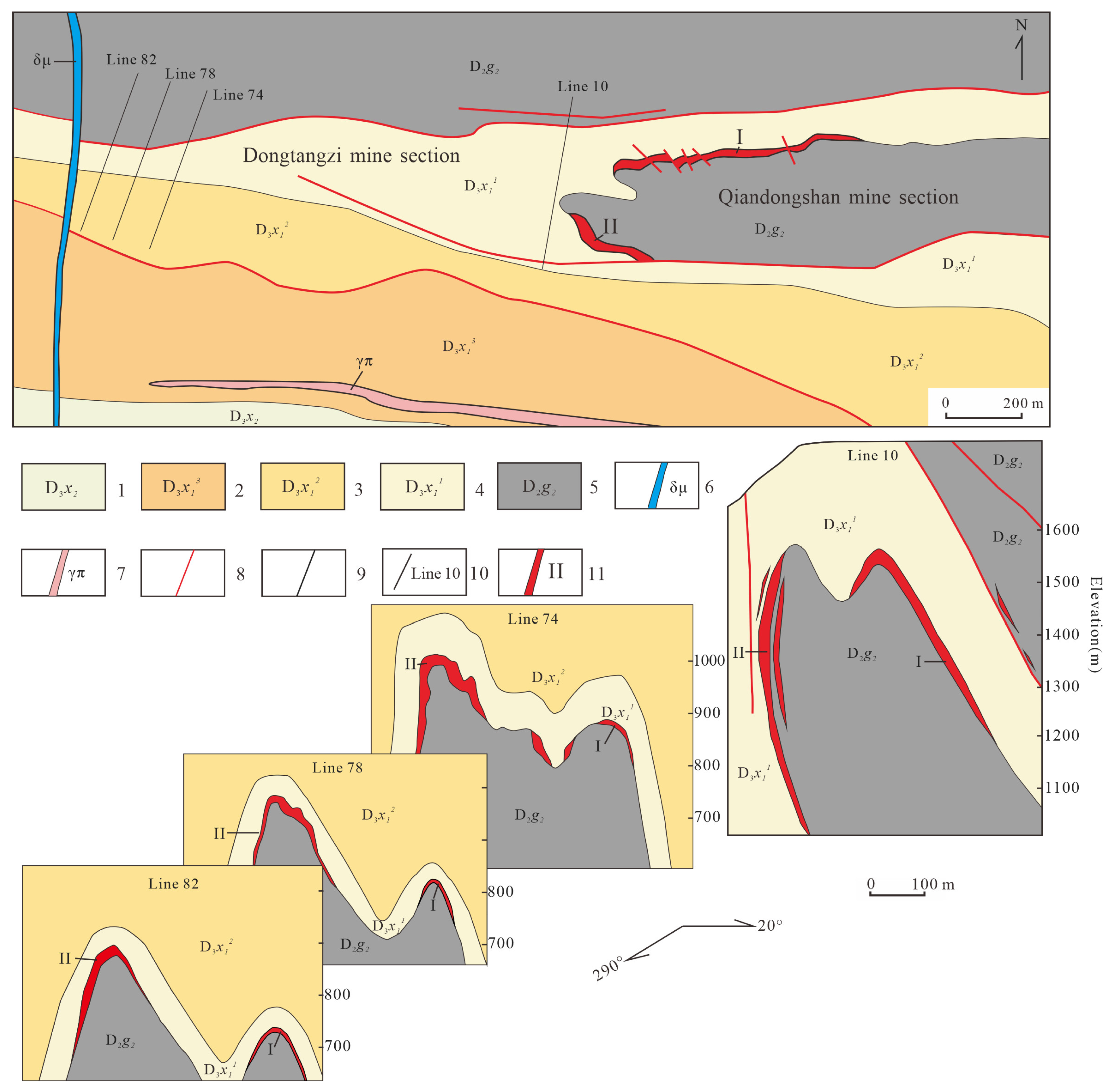
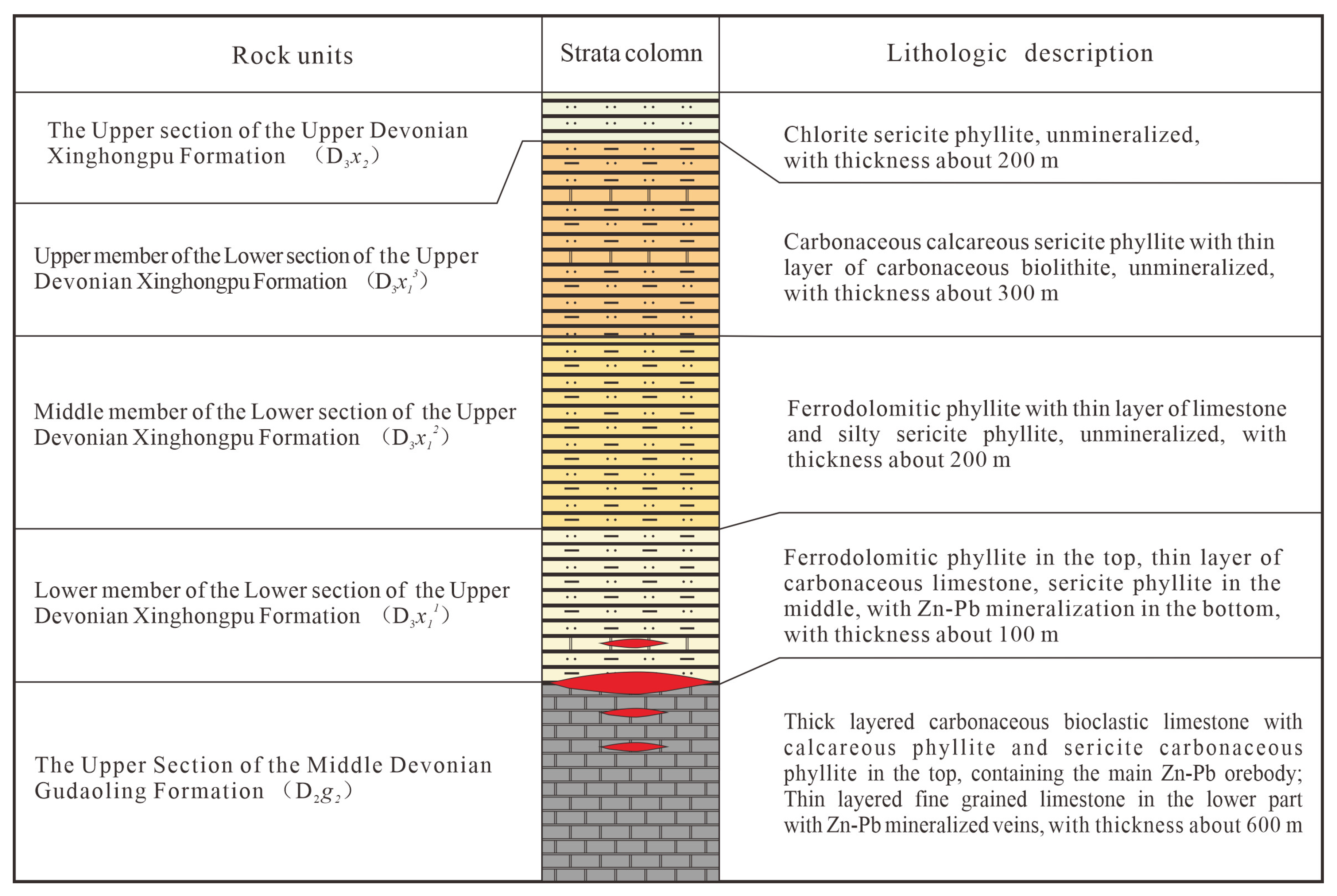
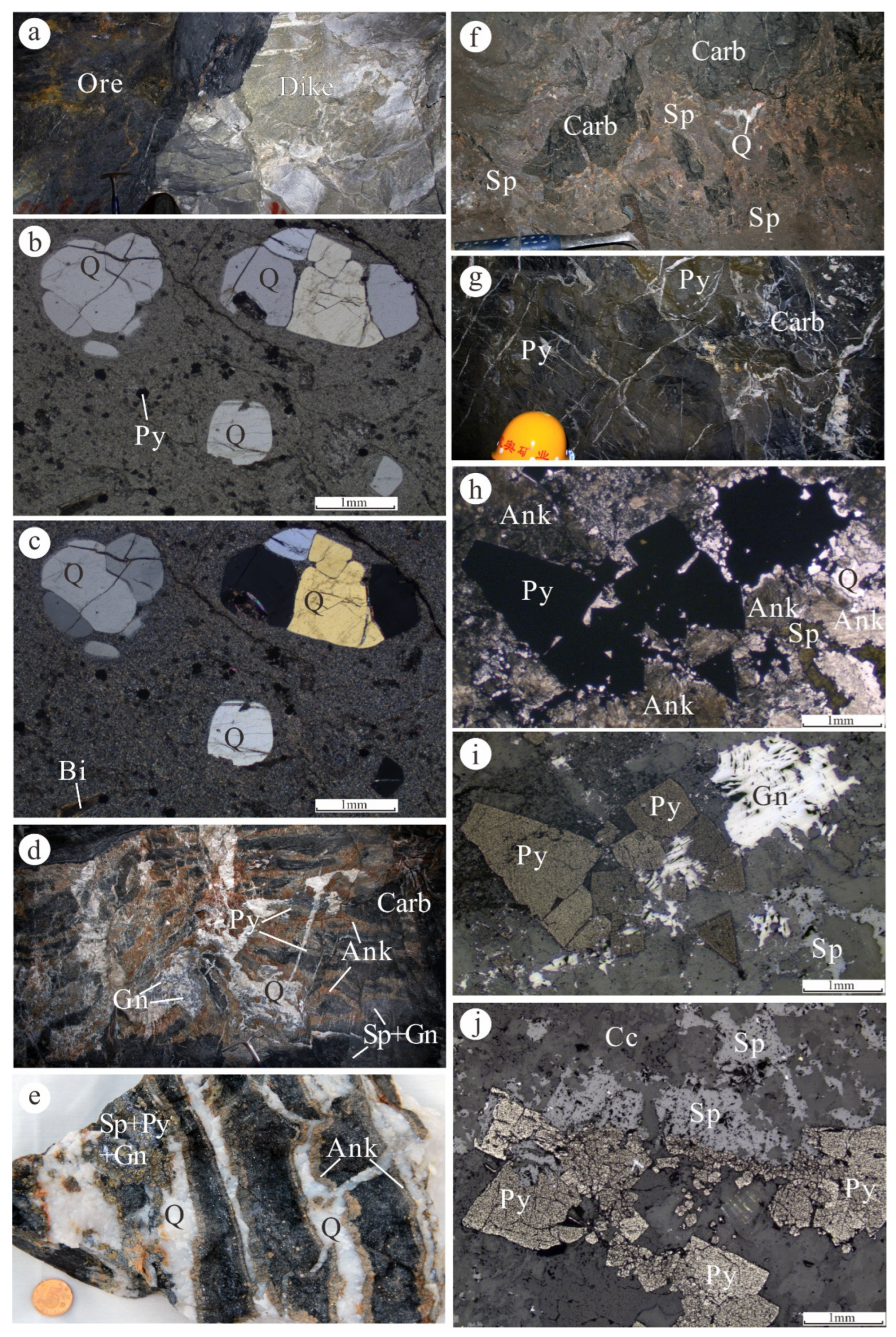




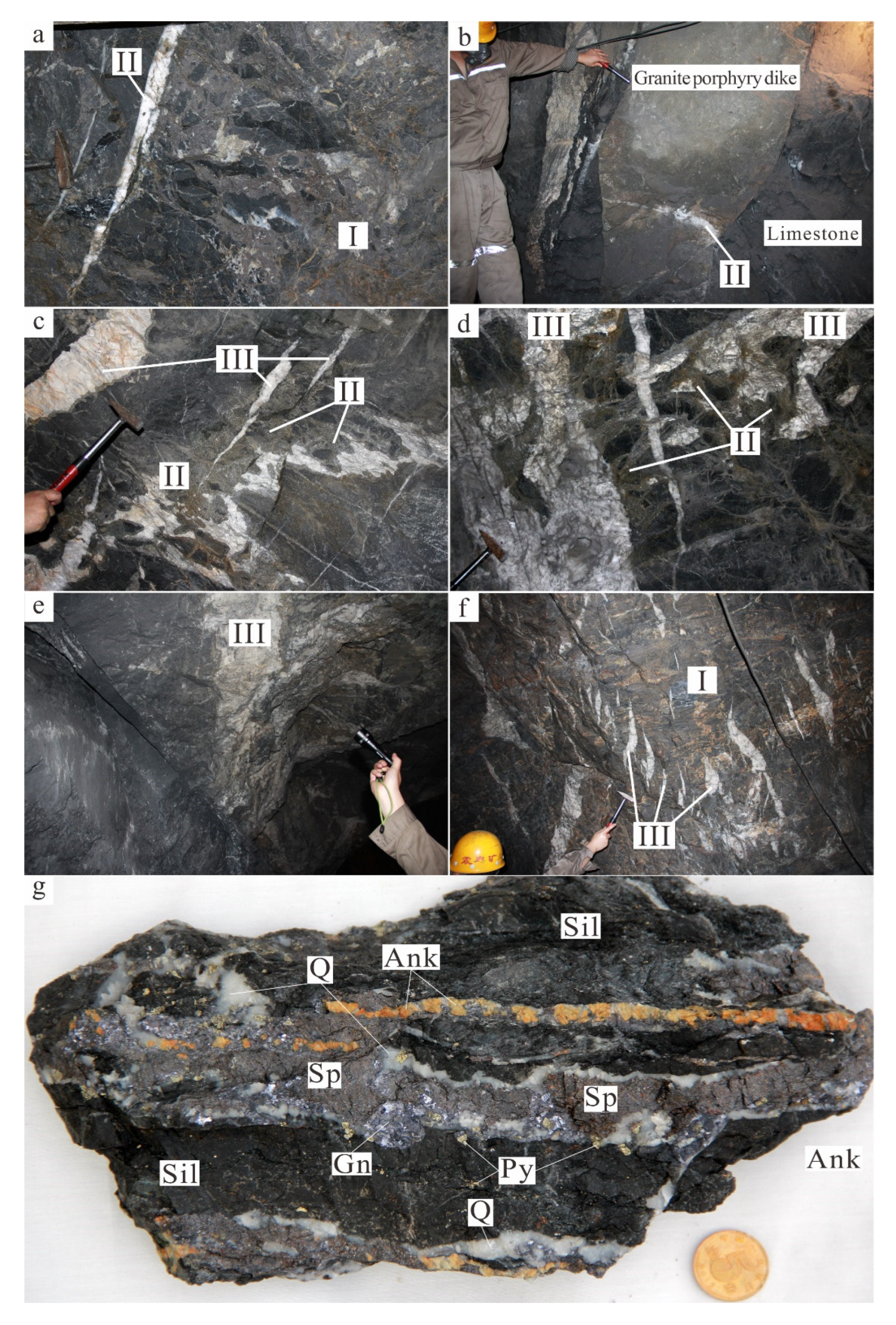
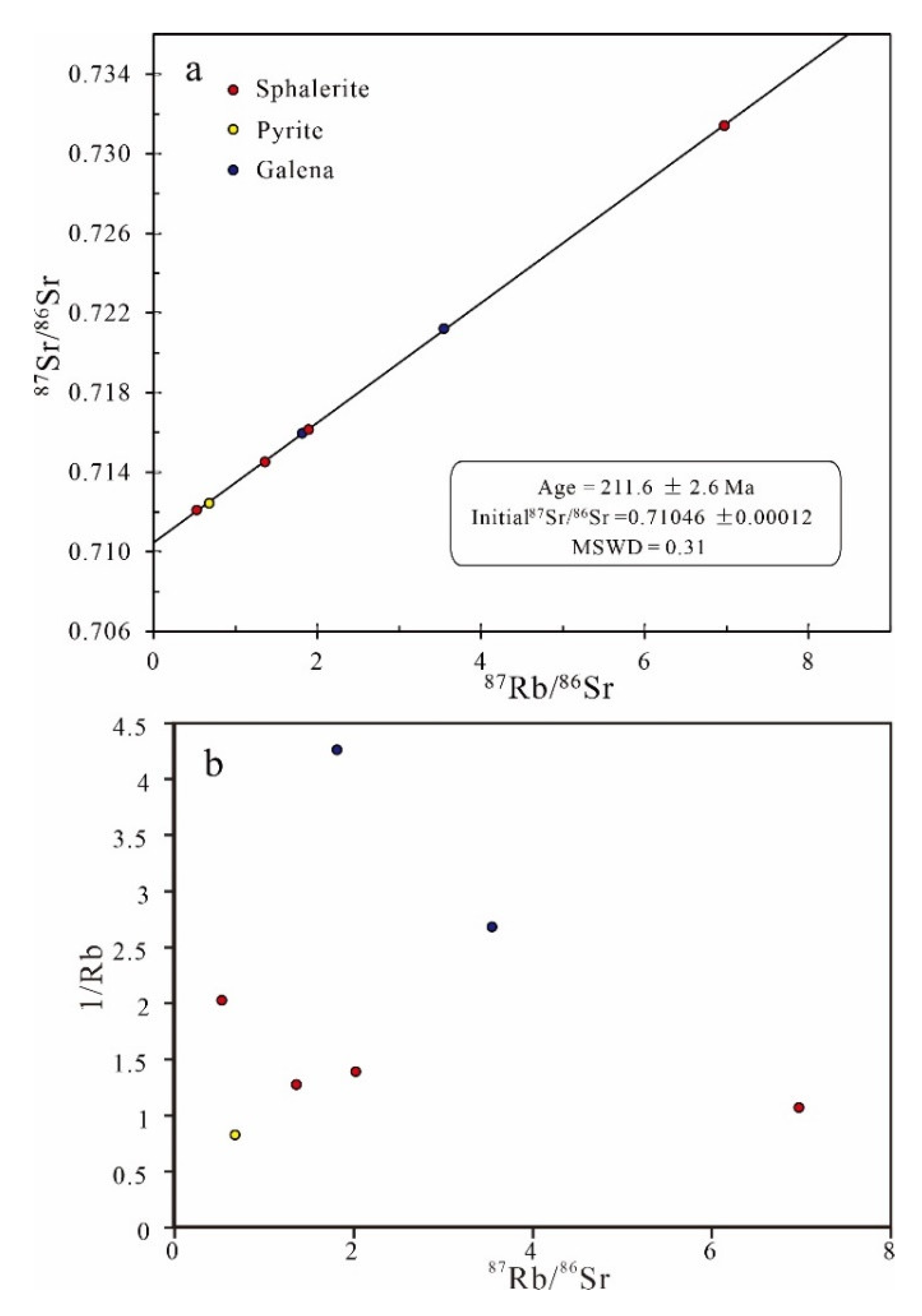

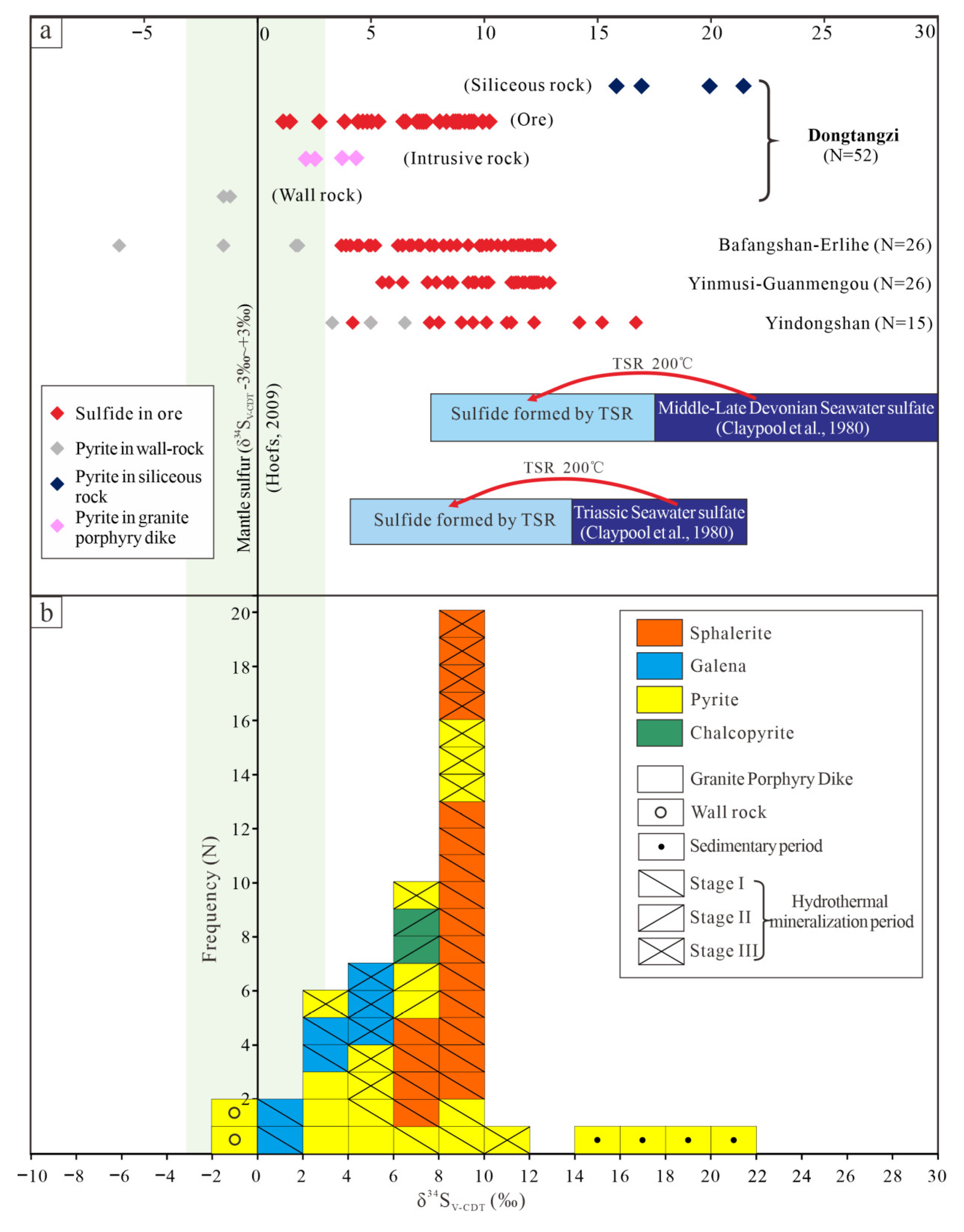
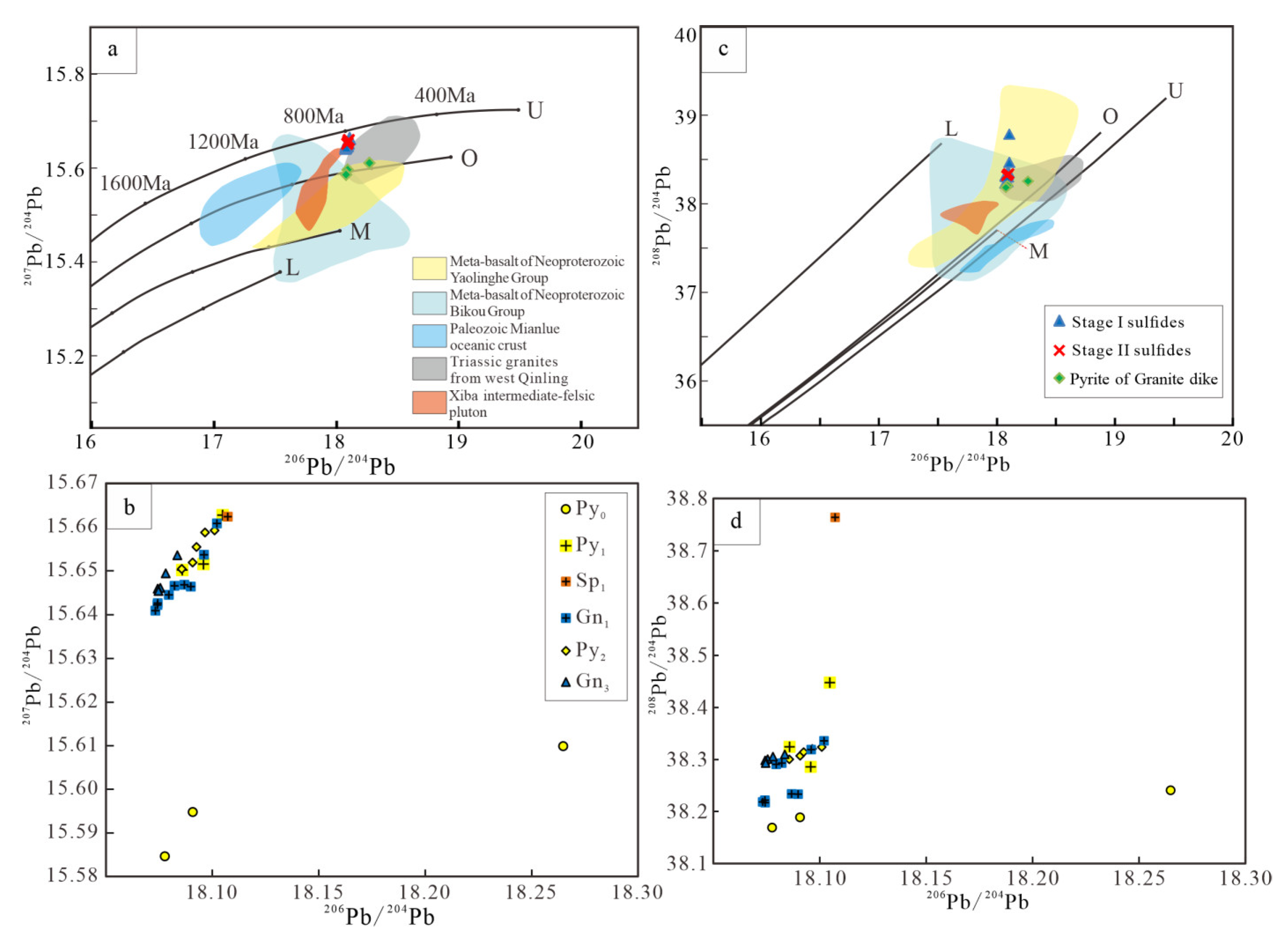
| No. | Sample | Position | Stage | Type | Description |
|---|---|---|---|---|---|
| 1 | D216.3-1 | 960 m elevation, north–south of the No.2 ore body | I | Siliceous rock | Siliceous rock with pyrite of the sedimentary period, intersected by the hydrothermal Stage I quartz–pyrite–galena veins |
| 2 | D22 | 1010 m elevation, south flank of the No.2 ore body | I | Disseminated ore | Lamellar carbonaceous altered rock, with disseminated medium-fine grained sphalerite |
| 3 | D28-4 | 960 m elevation, south flank of the No.2 ore body | I | Banded ore | Fine-grained quartz–ankerite–pyrite veins are zebra-striated in carbonaceous altered rocks |
| 4 | D29-1 | 960 m elevation, south flank of the No.2 ore body | I | Vein type ore | Quartz–dolomite–sphalerite–pyrite–galena veins developed in carbonaceous limestone |
| 5 | D45 | 960 m elevation, south flank of the No.2 ore body | I | Massive, brecciated ore | Medium-coarse-grained massive sphalerite–pyrite–dolomite aggregate, locally cementing breccias of carbonaceous altered rock |
| 6 | D48 | 860 m elevation, saddle part of the No.2 ore body | I | Disseminated ore | Fine-grained sphalerite, galena, pyrite, and dolomite are densely disseminated in altered rocks |
| 7 | DTZ-2-2 | 1060 m elevation, saddle part of the No.2 ore body | I | Mineralized carbonaceous limestone | Quartz–calcite veins are interspersed with carbonaceous limestone, with black aphanitic sphalerite developed at the edges |
| 8 | DTZ-1 | 1060 m elevation, south flank of the No.2 ore body | I | Mineralized carbonaceous phyllite | The carbonaceous phyllite contains lumpy, disseminated sphalerite, galena, and pyrite |
| 9 | DTZ-3-4 | 1060 m elevation, north flank of the No.2 ore body | I | Massive ore | Fine-grained black-brown lumpy sphalerite, with less quartz, pyrite, and galena |
| 10 | D41 | 860 m elevation, south flank of the No.2 ore body | I | Disseminated ore | Fine-grained sphalerite and ankerite are densely disseminated in grayish-black carbonaceous altered rocks |
| 11 | D213.2 | 960 m elevation, north flank of the No.2 ore body | I | Mineralized siliceous rock | Gray-black siliceous rock with disseminated fine-grained pyrite |
| 12 | D51-1 | 795 m elevation, south flank of the No.2 ore body | I | Disseminated ore | Fine-grained sphalerite, galena, pyrite, and dolomite are densely disseminated in altered rocks |
| 13 | D61-1 | 910 m elevation, saddle part of the No.2 ore body | I | Disseminated ore | Medium-fine-grained dense disseminated sphalerite, pyrite, and arsenopyrite are developed in silicified carbonaceous limestone |
| 14 | D229-1 | 960 m elevation, south flank of the No.2 ore body | I | Banded ore | Banded ankerite–sphalerite–pyrite–galena veins developed in altered carbonaceous limestone |
| 15 | D36 | 910 m elevation, south flank of the No.2 ore body | Granite porphyry dike | NWW-trending granite porphyry dike, nearly parallel to the ore body, with scattered pyrite | |
| 16 | D55 | 960 m elevation, south flank of the No.1 ore body | II | Disseminated ore | Quartz–dolomite stockwork developed in the limestone, with fine-grained arsenopyrite and pyrite aggregate developed at the contact area |
| 17 | D58 | 960 m elevation, south flank of the No.1 ore body | II | Disseminated ore | Silicified limestone with disseminated pyrite, interspersed by quartz–dolomite stockwork |
| 18 | D107-3 | 795 m elevation, south flank of the No.2 ore body | II | Massive ore | The massive medium-fine-grained pyrite–sphalerite–arsenopyrite–ankerite aggregates, interspersed by the Stage III coarse-grained calcite and galena veins |
| 19 | D109 | 795 m elevation, south flank of the No.2 ore body | II | Massive ore | Pyrite-rich massive ore, micro-fine grained pyrite aggregates, cementing carbonaceous altered breccia |
| 20 | D205.2 | 795 m elevation, south flank of the No.2 ore body | II | Vein type ore | Veinlets composed of quartz, calcite, pyrite, sphalerite, and galena, crosscutting the altered rocks |
| 21 | D26 | 960 m elevation, saddle part of the No.2 ore body | III | Vein type ore | The medium-fine-grained lumpy sphalerite, galena, and calcite vein developed in the altered carbonatite |
| 22 | D230 | 960 m elevation, south flank of the No.2 ore body | III | Disseminated ore | Veinlet-disseminated ore, mineralized siliceous rock crosscutting by quartz–calcite-pyrite veins |
| 23 | D37-2 | 910 m elevation, north flank of the No.1 ore body | III | Gold bearing ore | The altered marl, with disseminated pyrite, interspersed with quartz-dolomite-pyrite vein |
| 24 | D223.3 | 795 m elevation, south flank of the No.2 ore body | III | Gold bearing ore | Dense disseminated pyrite is developed in the altered rock, with quartz–calcite aggregates |
| Sample/Point No. | Stage | Mineral | δ34S (‰) |
|---|---|---|---|
| D216.3/1 | Sedimentary period | Pyrite | 16.9 |
| D216.3/2 | Pyrite | 15.8 | |
| D216.3/5 | Pyrite | 19.9 | |
| D216.3/6 | Pyrite | 21.4 | |
| D216.3/3 | Hydrothermal I | Sphalerite | 7.3 |
| D216.3/4 | Sphalerite | 8.7 | |
| D41/1 | Sphalerite | 9.1 | |
| D41/2 | Pyrite | 8.6 | |
| D41/3 | Sphalerite | 9.3 | |
| D41/4 | Sphalerite | 9.4 | |
| D41/5 | Sphalerite | 8.8 | |
| D51/1 | Pyrite | 8 | |
| D51/2 | Galena | 2.7 | |
| D51/3 | Sphalerite | 7.3 | |
| D51/4 | Sphalerite | 7 | |
| D51/5 | Sphalerite | 8 | |
| D51/6 | Galena | 1.4 | |
| D51/7 | Galena | 2.7 | |
| D51/8 | Pyrite | 7.1 | |
| D51/9 | Sphalerite | 7.1 | |
| D61/1 | Pyrite | 5.3 | |
| D61/2 | Sphalerite | 8.6 | |
| D61/3 | Galena | 1.1 | |
| D61/4 | Sphalerite | 8.8 | |
| D61/5 | Sphalerite | 8.9 | |
| D213.2/1 | Sphalerite | 8.3 | |
| D213.2/2 | Sphalerite | 8.8 | |
| D36.1/1 | Granite porphyry dike | Pyrite | 2.1 |
| D36.1/2 | Pyrite | 4.3 | |
| D36.1/3 | Pyrite | 3.7 | |
| D36.1/4 | Pyrite | 2.5 | |
| D205.2/1 | Hydrothermal II | Pyrite | 7.4 |
| D205.2/2 | Chalcopyrite | 6.4 | |
| D205.2/3 | Pyrite | 7.3 | |
| D205.2/4 | Chalcopyrite | 6.5 | |
| D26/1 | Hydrothermal III | Sphalerite | 9.9 |
| D26/2 | Galena | 4.4 | |
| D26/3 | Sphalerite | 9.5 | |
| D26/4 | Galena | 4.8 | |
| D26/5 | Sphalerite | 9.9 | |
| D26/6 | Pyrite | 10.2 | |
| D26/7 | Sphalerite | 9.3 | |
| D26/8 | Galena | 4.6 | |
| D223.3/1 | Pyrite | 8.9 | |
| D223.3/2 | Pyrite | 3.8 | |
| D223.3/3 | Pyrite | 5 | |
| D223.3/4 | Pyrite | 4.4 | |
| D223.3/5 | Pyrite | 8.7 | |
| D223.3/6 | Pyrite | 7.2 | |
| D223.3/7 | Pyrite | 8.3 |
| Sample/Point No. | Stage | Mineral | 208Pb/204Pb | 207Pb/204Pb | 206Pb/204Pb |
|---|---|---|---|---|---|
| D36/1 | Granite porphyry dike | Pyrite | 38.189 ± 0.010 | 15.595 ± 0.004 | 18.091 ± 0.011 |
| D36/2 | Pyrite | 38.241 ± 0.009 | 15.61 ± 0.004 | 18.101 ± 0.003 | |
| D36/3 | Pyrite | 38.169 ± 0.005 | 15.585 ± 0.002 | 18.092 ± 0.002 | |
| D51/2 | Hydrothermal I | Pyrite | 38.448 ± 0.005 | 15.663 ± 0.002 | 18.076 ± 0.003 |
| D51/3 | Pyrite | 38.286 ± 0.004 | 15.652 ± 0.001 | 18.078 ± 0.002 | |
| D51/4 | Pyrite | 38.324 ± 0.004 | 15.65 ± 0.002 | 18.074 ± 0.002 | |
| D51/1 | Sphalerite | 38.764 ± 0.026 | 15.662 ± 0.005 | 18.075 ± 0.001 | |
| D51/1 | Galena | 38.336 ± 0.008 | 15.661 ± 0.003 | 18.084 ± 0.001 | |
| D51/2 | Galena | 38.319 ± 0.007 | 15.654 ± 0.003 | 18.105 ± 0.002 | |
| D51/3 | Galena | 38.234 ± 0.006 | 15.647 ± 0.002 | 18.096 ± 0.002 | |
| D51/4 | Galena | 38.234 ± 0.009 | 15.646 ± 0.003 | 18.086 ± 0.002 | |
| D61/1 | Galena | 38.217 ± 0.004 | 15.643 ± 0.002 | 18.107 ± 0.005 | |
| D61/2 | Galena | 38.222 ± 0.007 | 15.642 ± 0.002 | 18.102 ± 0.003 | |
| D61/3 | Galena | 38.218 ± 0.005 | 15.641 ± 0.002 | 18.096 ± 0.002 | |
| D61/4 | Galena | 38.293 ± 0.001 | 15.647 ± 0.001 | 18.087 ± 0.002 | |
| D61/5 | Galena | 38.291 ± 0.004 | 15.645 ± 0.001 | 18.090 ± 0.003 | |
| D205-2/1 | Hydrothermal II | Pyrite | 38.307 ± 0.024 | 15.652 ± 0.009 | 18.074 ± 0.002 |
| D205-2/2 | Pyrite | 38.324 ± 0.006 | 15.659 ± 0.002 | 18.074 ± 0.002 | |
| D205-2/3 | Pyrite | 38.314 ± 0.005 | 15.655 ± 0.002 | 18.073 ± 0.002 | |
| D205-2/4 | Pyrite | 38.321 ± 0.005 | 15.659 ± 0.002 | 18.082 ± 0.001 | |
| D205-2/5 | Pyrite | 38.301 ± 0.007 | 15.65 ± 0.003 | 18.080 ± 0.001 | |
| D26/1 | Hydrothermal III | Galena | 38.301 ± 0.007 | 15.646 ± 0.003 | 18.097 ± 0.002 |
| D26/2 | Galena | 38.306 ± 0.005 | 15.649 ± 0.024 | 18.086 ± 0.003 | |
| D26/3 | Galena | 38.299 ± 0.006 | 15.646 ± 0.002 | 18.091 ± 0.004 | |
| D26/4 | Galena | 38.293 ± 0.003 | 15.645 ± 0.001 | 18.265 ± 0.005 | |
| D26/5 | Galena | 38.310 ± 0.003 | 15.654 ± 0.001 | 18.078 ± 0.002 |
| Sample No. | Mineral | Stage | Rb (μg/g) | Sr (μg/g) | 87Rb/86Sr | 87Sr/86Sr | 2σ |
|---|---|---|---|---|---|---|---|
| DTZ-2-2 | Spalerite | I | 0.4932 | 2.7590 | 0.5278 | 0.712041 | 0.000008 |
| DTZ-1 | Pyrite | I | 1.2070 | 5.2180 | 0.6794 | 0.712506 | 0.000008 |
| DTZ-1 | Galena | I | 0.2347 | 0.3742 | 1.8150 | 0.715902 | 0.000009 |
| DTZ-1 | Spalerite | I | 0.7834 | 1.6930 | 1.3620 | 0.714581 | 0.000010 |
| DTZ-3-4 | Galena | I | 0.3728 | 0.3105 | 3.5470 | 0.721159 | 0.000008 |
| DTZ-3-4 | Spalerite | I | 0.9346 | 0.3957 | 6.9710 | 0.731475 | 0.000009 |
| Sample No. | Mineral | Stage | Sm (×10−6) | Nd (×10−6) | 147Sm/144Nd | 143Nd/144Nd |
|---|---|---|---|---|---|---|
| D22 | Dolomite | I | 0.1605 | 3.527 | 0.1351 | 0.511943 ± 9 |
| D28-4 | Ankerite | I | 0.6537 | 2.678 | 0.7195 | 0.512739 ± 7 |
| D29-1 | Dolomite | I | 0.4058 | 4.634 | 0.2586 | 0.512081 ± 8 |
| D45-31 | Dolomite | I | 0.1325 | 5.336 | 0.0731 | 0.511851 ± 8 |
| D45-32 | Dolomite | I | 0.3536 | 5.781 | 0.1803 | 0.511982 ± 7 |
| D48 | Dolomite | I | 0.2953 | 4.013 | 0.2175 | 0.512024 ± 9 |
| D55 | Dolomite | II | 0.4831 | 3.907 | 0.3656 | 0.512229 ± 14 |
| D58 | Calcite | II | 0.5029 | 2.694 | 0.5498 | 0.512501 ± 8 |
| D58 | Dolomite | II | 0.1847 | 5.325 | 0.1023 | 0.511875 ± 9 |
Disclaimer/Publisher’s Note: The statements, opinions and data contained in all publications are solely those of the individual author(s) and contributor(s) and not of MDPI and/or the editor(s). MDPI and/or the editor(s) disclaim responsibility for any injury to people or property resulting from any ideas, methods, instructions or products referred to in the content. |
© 2024 by the authors. Licensee MDPI, Basel, Switzerland. This article is an open access article distributed under the terms and conditions of the Creative Commons Attribution (CC BY) license (https://creativecommons.org/licenses/by/4.0/).
Share and Cite
Hu, Q.; Wang, Y.; Chen, S.; Wei, R.; Liu, X.; Liu, J.; Wang, R.; Gao, W.; Wang, C.; Tang, M.; et al. Genesis of the Dongtangzi Zn-Pb Deposit of the Fengxian–Taibai Ore Cluster in West Qinling, China: Constraints from Rb-Sr and Sm-Nd Geochronology, and In Situ S-Pb Isotopes. Minerals 2024, 14, 297. https://doi.org/10.3390/min14030297
Hu Q, Wang Y, Chen S, Wei R, Liu X, Liu J, Wang R, Gao W, Wang C, Tang M, et al. Genesis of the Dongtangzi Zn-Pb Deposit of the Fengxian–Taibai Ore Cluster in West Qinling, China: Constraints from Rb-Sr and Sm-Nd Geochronology, and In Situ S-Pb Isotopes. Minerals. 2024; 14(3):297. https://doi.org/10.3390/min14030297
Chicago/Turabian StyleHu, Qiaoqing, Yitian Wang, Shaocong Chen, Ran Wei, Xielu Liu, Junchen Liu, Ruiting Wang, Weihong Gao, Changan Wang, Minjie Tang, and et al. 2024. "Genesis of the Dongtangzi Zn-Pb Deposit of the Fengxian–Taibai Ore Cluster in West Qinling, China: Constraints from Rb-Sr and Sm-Nd Geochronology, and In Situ S-Pb Isotopes" Minerals 14, no. 3: 297. https://doi.org/10.3390/min14030297





